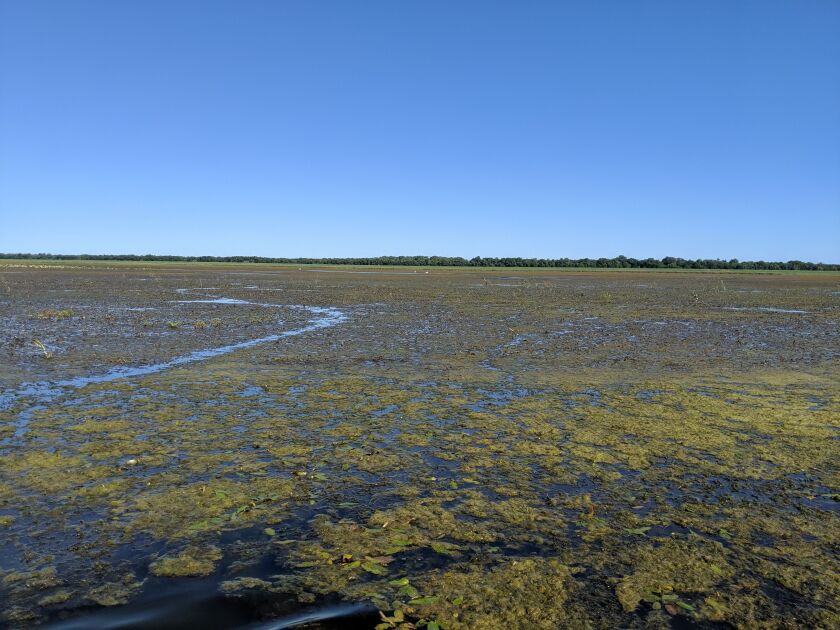LEWISTOWN, Ill.--Six American white pelicans flew low over Route 97 as I barreled north out of Havana toward Thompson Lake at Emiquon Preserve. They were so close it struck me again just how big they are, seemingly far bigger than when seen in distant squadrons.
The Illinois Natural History Survey lists American white pelicans as having bodies to five feet with wing spans to nine feet. Sounds right.
Big, kind of like the plans The Nature Conservancy has had for Emiquon, ``once . . . the jewel of the Illinois River, nurturing diverse and abundant communities of native plants and animals in the complex system of backwater wetlands and lakes.’’
TNC describes plans for Emiquon to be ``the premiere demonstration site for The Nature Conservancy’s work on the Illinois River and within the Upper Mississippi River system and ultimately will help guide large floodplain river restoration efforts around the world.’’
Last Saturday, I went to the Paddle the Preserve, which had 81 sign up to paddle Emiquon in voyageur canoes and a flotilla of two-person canoes and kayaks. It was the second time I’ve paddled Thompson Lake, biggest body of water on Emiquon and the one open to public fishing, birding and waterfowling.
I fished Emiquon in its opening years when bass anglers routinely had 100-fish days. I’ve hiked upland portions, went sightseeing when I was nearby, joined a flyover with TNC and Ducks Unlimited staff during the historic 2013 flood and tagged along on a bluebill (scaup) study with INHS.
Emiquon is that kind of special.
Half of our paddle was east of the island, a part generally restricted. The plan was to paddle to a breach in the island, then paddle into the wind down a ditch through lotus, longleaf pond weed (American pondweed) and other aquatic plants.
``Way we have this planned, the wind will blow us back,’’ said Mitch Baalman, a wildlife refuge specialist with the U.S. Fish and Wildlife Service.
That brought laughter from the crowd, most of whom know such excursions rarely go exactly as planned. This one went as planned.
The three voyageur canoes launched first, then the canoes and kayaks.
I was in the lead voyageur canoe, captained by Baalman. I sat in back between stern man Caleb Kotewa of Dickson Mounds Museum and Steve and Carol Smith, missionaries from the Ivory Coast back visiting family.
Once we found the breach in the island, I was reminded how big lotus pads were when we paddled through them.
``The lotus pads were not planted,’’ Baalman said. ``They had survived in the soil bank for 100 years.’’
They returned on their own when the backwater stopped being drained for cropland.
We drifted by a large muskrat house. Ducks, mainly wood ducks, took off sporadically from thick aquatic vegetation. I also saw two big flocks of blue-winged teal wheel off in classic banking patterns. At least a couple endangered black-crowned night herons flew.
``Emiquon is a McDonald’s for ducks,’’ Baalman said. ``There’s not a lot of overwintering habitat. Basically, it is a fast-food restaurant for ducks. They stay three-four-five days, then continue their migration.’’
I only saw one fish splash off. Sportfishing is not what it was in early years, but there are surprises in recent years: Some good, some not so good.
In a follow-up email, Doug Blodgett, director of river conservation at TNC’s Illinois Rivers Program, said they stocked 33 native fish species into Emiquon, most in 2007. Since then, they have found 22 of those species in efforts with various partners.
``It’s possible more persist as some are tough to collect with the gears that partners use to monitor the fish community,’’ he emailed. ``Collectively we’ve documented 22 additional species that we didn’t stock. Unfortunately that list includes five non-native species including common carp.
``I was pleasantly surprised when two robust paddlefish were collected this past year and one additional was observed but not landed.’’
Common carp, holdovers from the ditches, are a bigger threat than bighead and silver carp to the restoration efforts.
One recent rave fish is bowfin (dogfish) with reports of them near Illinois-record size.
At the mid-way break, Blodgett answered questions, including on duck blinds. That’s worth exploring another day, but short answers are that leasing hunting rights covers property taxes TNC voluntarily pays. Public hunting shows how natural restoration can work for waterfowling as well as flooding cornfields.
After the break, the wind powered us back so quickly lots of daylight remained.
It was time.
I look forward to next year.
Blodgett said that during the 20th anniversary celebration, there will be paddling events all day and a 12-mile hike along the levy. I want to do that hike.
Much info is at facebook.com/IllinoisRiverNWFR/. For the complex around Emiquon, go to experienceemiquon.com. For Emiquon, call (309) 547-2730.







